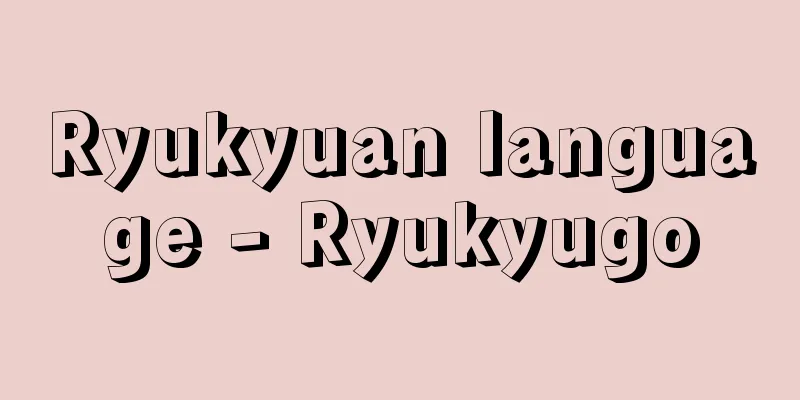Ryukyuan language - Ryukyugo

|
Among the languages that developed from the original Japanese language, the language that developed in the Ryukyu Islands south of Amami Oshima in Kagoshima Prefecture is called the Ryukyuan language or Ryukyuan dialect. Because the Shuri dialect, which played the role of the Ryukyu common language, belongs to Okinawa, it is sometimes called the Okinawan language or Okinawan dialect. [Masatomo Nakamoto] Language environment and divisionAlthough the Ryukyuan language developed from the original Japanese language, it is a language with enough uniqueness that it is in conflict with all mainland dialects, and there are also large differences in the dialects within the language. There are two reasons for this. The first is the geographical factor of the Ryukyu Islands, with nearly 60 islands stretching from north to south, and the second is the cultural factor of the islands being positioned within a layered structure of a central region and a periphery. Because the Ryukyu Islands are located far from the central sphere of Japanese culture, they do not necessarily directly accept events that correspond to the historical transitions of the central sphere, and even if they did, it is natural that the way of acceptance differs from island to island, since they are a group of many islands. The largest entrance for cultural acceptance in the Ryukyu Islands is the "Okinawaguchi" in the central and southern part of Okinawa Island, from which the culture of the Ryukyu Kingdom was completed by incorporating Yamato culture, as well as the cultures of China, Korea, and the surrounding countries to the south. As the accepted culture spreads to the surrounding areas, it passes through Naze on Amami Oshima in the north, Ishigaki on the Yaeyama Islands in the south, and Hirara on Miyako Island, and finally reaches the acceptance point of each island. In this way, it passes through several relay points before reaching each island from the central sphere, and depending on the island, it can take a long time. As a result, each island is subtly colored according to its distance from the central sphere. Looking at the dialects within the Ryukyuan language today, we see that they are layered with large and small characteristics. They are roughly divided into Northern Ryukyu, which combines the Okinawa and Amami regions, and Southern Ryukyu (Sakishima Islands), which combines the Miyako and Yaeyama regions, and the differences between the dialects within each are large. Even from the perspective of dialects that are so different that they cannot be understood, they are divided into five: the Okinawa dialect of Northern Ryukyu, the Amami dialect, and the Miyako dialect, Yaeyama dialect, and Yonaguni dialect of Southern Ryukyu. The difference between the Tohoku dialect and the Kagoshima dialect, which belong to a category separated by a large distance in the Japanese archipelago, is not as great as the internal differences of the Okinawa dialect, which is one of the five major dialects of the Ryukyuan language. That is how large the differences between the dialects of the Ryukyuan language are. [Masatomo Nakamoto] Historical backgroundEach island had its own language, and around the time of the transition from the Jomon to the Yayoi period, the influence of the original Japanese language gradually spread throughout the Ryukyu Islands. What was the state of relations between the islands and the Yamato court? According to the "Nihon Shoki" (720), Yaku (Yakushima) in 616, Tane (Tanegashima) in 677, and Amami (Amami) in 682. According to the "Shoku Nihongi" (792), Toku (Tokunoshima) in 699, Shika (Ishigakijima) and Kumi (Kumejima) in 714 all negotiated with the Yamato court, offering gifts and bestowing ranks and stipends. The fact that records are made on an island-by-island basis suggests that at the time the islands were probably independent and there was a large gap in language between them. The rule of powerful clans began in the 12th century, and the path to the Ryukyu Kingdom began. Okinawa was divided into Hokuzan, Chuzan, and Nanzan, and was unified into Chuzan in 1429, forming the Ryukyu Kingdom. A centralized system was established during the reign of King Sho Shin from 1477 to 1526, and in the process of building the kingdom, the culture of the Ryukyu Kingdom was absorbed, and it was here that the culture of the Ryukyu Kingdom blossomed. It was around this time that the dialect of Shuri, the center of the Ryukyu Kingdom, gained the status of the common language of Ryukyu, and began to influence the surrounding areas. The language of this period is recorded in the ancient song collection Omoro Saushi (1532-1623) and the ancient dictionary Konkogenshu (1711). The Shimazu clan's rule of Ryukyu in 1609 triggered a strong wave of Yamato-ism, which led to the gradual decline of Ryukyu Kingdom culture, and with the abolition of the feudal domains and establishment of prefectures in the Meiji period, the uniqueness of Ryukyu culture was lost. The Ryukyuan language developed against this historical background and has followed its own unique history. [Masatomo Nakamoto] Linguistic featuresThe Ryukyuan language has retained many archaic words. During the Nara period, the Japanese words for "foot" were "hagi" and "ashi," with "hagi" referring to "shin" and "ashi" referring to the area below the ankle. In modern Japanese, "ashi" refers not only to the area below the ankle but to the entire leg, and "hagi" remains as a fossil in "calf" and has disappeared as a word referring to the entire leg. However, in Ryukyu, the Pagi family of words corresponding to "hagi" remain as words to refer to the entire leg, but because new words from the Pisa family that refer to the entire leg have emerged mainly in Okinawa, the Pagi family remains in Amami in the north and Miyako and Yaeyama in the south, showing a typical circumferential distribution. The Ryukyuan language is diverse. For example, for words meaning "head," there are Kamachi family words on Amami Oshima and Kikaijima, Akamachi family words on Yaeyama, Karaji family words on Tokunoshima and Yoronjima, Tsuburu family words on Okinawa and Okinoerabujima, Kanamari family words on Miyako, and Ukkan family words on Tokunoshima, with different family lines distributed across the islands. The Ryukyuan language has many layers of modern and ancient language, and has a deep historical layer. Many words are connected to archaic words, such as akejuu (akitsu, dragonfly), tuji (toji, wife), and anma (amo, mother). The Ryukyuan language still retains its old layer of phonology and grammar, with the presence of the archaic p sound of the ha-row and the use of compound words. Even when looking at the new layer of linguistic change, the islands are undergoing dramatic regional transformations. The Ryukyuan language, which has continued to follow its own path, is gradually losing its linguistic uniqueness as the distance between it and the central sphere has narrowed due to the development of radio and television. [Masatomo Nakamoto] "Dictionary of the Okinawan Language" edited by the National Institute for Japanese Language and Linguistics (1963, Printing Bureau of the Ministry of Finance)" ▽ " Dictionary of the Nakijin Dialect of Okinawa" edited by Nakasone Masayoshi (1983, Kadokawa Shoten) " ▽ "Studies on the Phonology of the Ryukyu Dialect " by Nakamoto Masatomo (1976, Hosei University Press) " ▽ "Illustrated Dictionary of the Ryukyuan Language" by Nakamoto Masatomo (1981, Chikaratomi Shobo)" ▽ "Studies on the History of Ryukyu Vocabulary" by Nakamoto Masatomo (1983, Sanichi Shobo)" ▽ "The Lineage of the Japanese Language" by Hattori Shiro (1959, Iwanami Shoten)" ▽ "Studies on the Ryukyu Yonaguni Dialect" by Hirayama Teruo and Nakamoto Masatomo (1964, Tokyodo Publishing) " ▽ "The Linguistic History of Okinawa" by Tokama Moriyoshi (1971, Hosei University Press)" ▽ "Okinawa Fubutsushi" by Masatomo Nakamoto and Minoru Higa (1984, Taishukan Shoten) Source: Shogakukan Encyclopedia Nipponica About Encyclopedia Nipponica Information | Legend |
|
原日本語から発達した言語のうち、鹿児島県下の奄美(あまみ)大島から南の琉球列島で発達した言語を琉球語または琉球方言という。琉球共通語の役割を果たした首里方言が沖縄に属しているために、沖縄語または沖縄方言とよばれることもある。 [中本正智] 言語の環境と区画琉球語は原日本語から発達したとはいえ、本土方言全体と対立するほど独自性のある言語であり、また、内部の方言差も大きい。その要因は二つある。一つは60に近い島々が南北に連なっているという琉球列島の地理的要因であり、もう一つはこれらの島々が中央圏と周辺部という重層的な構図のなかに位置づけられているという文化的要因である。 琉球列島が日本文化の中央圏から遠い所に位置しているため、かならずしも中央圏の歴史的な推移に対応する事象をじかに受容するというわけでなく、たとえ受容したとしても、多島をなしているため、島ごとに受容の仕方が異なるのが自然である。琉球列島の文化受容の最大の入口は沖縄本島中南部の「沖縄口」であり、ここから大和(やまと)文化をはじめ、中国、朝鮮、南方の周辺諸国の文化を取り入れて、琉球王国の文化が完成するのである。受容した文化が周辺に浸透していくとき、北は奄美大島の名瀬、南は八重山(やえやま)列島の石垣、宮古島の平良(ひらら)などを経て、最終的に各島々の受容口に至る。このように、中央圏から各島々に達するまでに、いくつかの中継地を経るため、島によっては長時間を要することがある。中央圏からの遠近に応じて各島々は微妙に色分けされる結果となっている。 現在の琉球語内部の方言をみると、大小の特色が重層をなしている。大きく沖縄・奄美の両地域をあわせた北琉球と、宮古・八重山の両地域をあわせた南琉球(先島(さきしま)諸島)とに分かれ、しかもそれぞれの内部の方言差は大きい。方言どうしが通じないほど差のあるものという観点からしても、北琉球の沖縄方言、奄美方言、南琉球の宮古方言、八重山方言、与那国(よなぐに)方言の五つに分かれる。日本列島で隔たっている部類に属する東北方言と鹿児島方言の差は、琉球語の五大方言の一つである沖縄方言の内部差ほどもない。それほど琉球語の方言差は大きい。 [中本正智] 時代的背景島ごとに多彩な言語が使われているところへ、縄文期から弥生(やよい)期に移ったころから、琉球全域に原日本語の影響が緩やかに浸透していったのであろう。島々と大和朝廷の交渉はどうだったであろうか。『日本書紀』(720)によると、掖久(やく)(屋久島(やくしま))が616年に、多禰(たね)(種子島(たねがしま))が677年に、阿摩彌(あまみ)(奄美)が682年に、『続日本紀(しょくにほんぎ)』(792)によると、度感(とく)(徳之島)が699年に、信覚(しか)(石垣島)、球美(くみ)(久米(くめ)島)が714年に、それぞれ大和朝廷と交渉をもち、方物を献上したり、人々が位階を授かったり、禄(ろく)を賜ったりしたことがみえる。島単位で記録されているところから、おそらく、当時、島々が独立形態をとり、言語の溝も大きかったのではなかろうか。 12世紀に豪族の支配が始まり、琉球王国へ歩み始めた。沖縄は北山、中山、南山の分立を経て、1429年中山に統一され、琉球王国の形態が整った。尚真王の1477年から1526年までに中央集権体制が確立され、王国建設の過程で周辺諸国の文化を摂取し、ここに琉球王国の文化が開花する。このころから琉球王国の中心地首里の方言が琉球共通語の地位を得て、周辺部に影響を及ぼし始めるのである。この期の言語は古謡集『おもろさうし』(1532~1623)や古辞書『混効験集』(1711)のなかに採録されている。 1609年の島津氏の琉球支配は、強い大和化の波をおこし、琉球王国の文化がしだいに衰微する結果をもたらし、明治の廃藩置県で琉球文化の独自性は失われていった。 琉球語はこのような歴史的な背景のもとで発達し、独自の歴史をたどってきている。 [中本正智] 言語的特徴琉球語は古語をよく残している。奈良朝期の「足」を表す日本語は「はぎ」と「あし」であり、「はぎ」は「脛(すね)」を、「あし」は踝(くるぶし)から下を表していた。現代日本語では、「あし」が踝から下の部分だけでなく、脚全体を表すようになっていて、「はぎ」は「ふくらはぎ」に化石的に残り、脛全体を表す語としては滅んでいる。ところが、琉球では、「はぎ」に対応するパギ系の語が脚全体を表す語として残っているけれど、沖縄を中心に脚全体を表すピサ系の語が新しく発生したために、パギ系は北の奄美と、南の宮古・八重山に残って、典型的な周圏分布を示している。 琉球語は多彩である。「頭」を表す語ならば、カマチ系が奄美大島と喜界島に、アカマチ系が八重山に、カラジ系が徳之島と与論島に、ツブル系が沖縄と沖永良部(おきのえらぶ)島に、カナマリ系が宮古に、ウッカン系が徳之島にあって、異なる系統の語が島々に分布している。 琉球語は新古の層が幾重にも重なり、それだけ時代層が深い。アーケージュー(あきつ、蜻蛉(とんぼ))、トゥジ(とじ、妻)、アンマー(あも、母)など古語につながる語が多い。 ハ行古音のp音があったり、係り結び法があったり、音韻と文法の面でも古い層を残している。言語変化の新しい層をみても、島々の地域的な変容が激しい。こうした独自の歩みを続けてきた琉球語は、ラジオやテレビの発達のため中央圏との距離が縮まり、しだいに言語的な独自性を失っている。 [中本正智] 『国立国語研究所編『沖縄語辞典』(1963・大蔵省印刷局)』▽『仲宗根政善編『沖縄今帰仁なきじん方言辞典』(1983・角川書店)』▽『中本正智著『琉球方言音韻の研究』(1976・法政大学出版局)』▽『中本正智著『図説琉球語辞典』(1981・力富書房)』▽『中本正智著『琉球語彙史の研究』(1983・三一書房)』▽『服部四郎著『日本語の系統』(1959・岩波書店)』▽『平山輝男・中本正智著『琉球与那国方言の研究』(1964・東京堂出版)』▽『外間守善著『沖縄の言語史』(1971・法政大学出版局)』▽『中本正智・比嘉実著『沖縄風物誌』(1984・大修館書店)』 出典 小学館 日本大百科全書(ニッポニカ)日本大百科全書(ニッポニカ)について 情報 | 凡例 |
<<: Ryukyu blacktip (English name) Diospyros ferrea (Willd.) Bakhuizen.
Recommend
Dry pampas - Dry pampas
…There are few trees, and ombú (a type of grass) ...
Fair Trade Commission
A specialized agency responsible for enforcing th...
Karazaike - Karazaike
(1) A class of farmers in the early modern period....
Cano, Alonso
Born: March 19, 1601, Granada Died September 3, 16...
Copper Pot - Dowan
A bronze kanamari (pot). It is a type of Buddhist ...
Ueki Emori - Plants and Branches
A thinker and advocate of freedom and civil right...
Leonardo Pisano (English spelling)
…the first great mathematician born in Christian ...
Varlin, Eugène
Born: 1839, Craiseries, near Paris [Died] May 28, ...
Tran Thu Do (English spelling)
…During his reign (1175-1210), he allowed the ris...
Orchomenos - Orchomenos (English spelling)
An ancient city in central Greece, northern Boeot...
Lepidasthenia longissima
...About 45 species of the family Pectinatidae ar...
Princess Toichi - Princess Toichi
Year of death: 7th April 678 (3rd May 678) Year of...
Berlin Conference
An international conference was held in Berlin fr...
Shishkin, Ivan Ivanovich
Born: January 25, 1832 in Elabuga [Died] March 20,...
Color
…The word sakana has been used since the Middle A...









